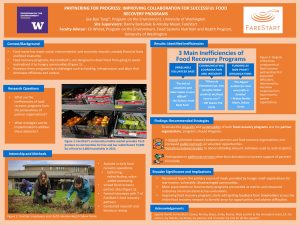THE SURVIVAL OF FOOD RECOVERY PROGRAMS: UNDERSTANDING THE CHALLENGES AND OPPORTUNITIES FOR PARTNER ORGANIZATIONS
Food recovery is an important aspect of the global food system, as it diverts food from going to waste, and redirects it for human consumption to people who need it most. Typically, recovered food comes from gleaning, which is gathering excess produce or crops after harvest, and donations from growers, commercial produce farmers, distributors, grocery stores, and farmer’s markets. These entities partner with food recovery organizations to minimize produce loss and improve food security, especially for vulnerable, socially disadvantaged communities. However, food recovery programs are new, and each can adopt a different model for food rescue. This makes it difficult to compare effectiveness between programs, especially when effectiveness metrics are inconsistently measured, and studied outcomes vary across assessments. The aim of this study is to assess the inefficiencies of FareStart food recovery program from the perspectives of partner organizations. To accomplish this, I assisted FareStart in daily food recovery operations and conducted formal interviews with FareStart food recovery programs focused on the successes, challenges, and impacts the partner organizations experienced. Alongside these interviews I conducted a literature review on existing studies to contextualize my project to a broader scope of food recovery programs. Findings show that FareStart partners struggle with funding as non-profit organizations, with a reliable volunteer base, and with unclear use, impact, and recipients of their donations. Understanding how to best support food recovery partners can ensure the longevity of the program, and the impact it has on alleviating food insecurities and reducing food waste in local communities.
